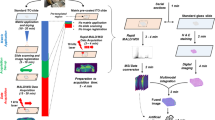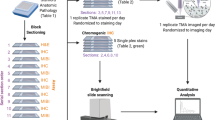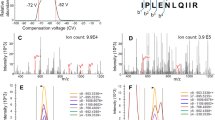Abstract
Imaging mass spectrometry (IMS) using matrix-assisted laser desorption ionization (MALDI) is a new and effective tool for molecular studies of complex biological samples such as tissue sections. As histological features remain intact throughout the analysis of a section, distribution maps of multiple analytes can be correlated with histological and clinical features. Spatial molecular arrangements can be assessed without the need for target-specific reagents, allowing the discovery of diagnostic and prognostic markers of different cancer types and enabling the determination of effective therapies.
This is a preview of subscription content, access via your institution
Access options
Subscribe to this journal
Receive 12 print issues and online access
$209.00 per year
only $17.42 per issue
Buy this article
- Purchase on Springer Link
- Instant access to full article PDF
Prices may be subject to local taxes which are calculated during checkout




Similar content being viewed by others
References
Liebl, H. Ion microprobe mass analyzer. J. Appl. Phys. 38, 5277–5283 (1967).
Castaing, R. & Slodzian, G. Microanalysis by secondary ionic emission. J. Microsc. 1, 395–410 (1962).
Esquenazi, E., Yang, Y. L., Watrous, J., Gerwick, W. H. & Dorrestein, P. C. Imaging mass spectrometry of natural products. Nat. Prod. Rep. 26, 1521–1534 (2009).
Fragu, P., Klijanienko, J., Gandia, D., Halpern, S. & Armand, J. P. Quantitative mapping of 4′-iododeoxyrubicin in metastatic squamous cellcarcinoma by secondary ion mass spectrometry (SIMS) microscopy. Cancer Res. 52, 974–977 (1992).
Pacholski, M. L. & Winograd, N. Imaging with mass spectrometry. Chem. Rev. 99, 2977–3006 (1999).
Chandra, S. & Lorey, D. R. SIMS ion microscopy in cancer research: single cell isotopic imaging for chemical composition, cytotoxicity and cell cycle recognition. Cell. Mol. Biol. (Noisy-le-grand) 47, 503–518 (2001).
Caprioli, R. M., Farmer, T. B. & Gile, J. Molecular imaging of biological samples: localization of peptides and proteins using MALDI-TOF MS. Anal. Chem. 69, 4751–4760 (1997).
Seeley, E. H. & Caprioli, R. M. Molecular imaging of proteins in tissues by mass spectrometry. Proc. Natl Acad. Sci. USA 105, 18126–18131 (2008).
Chaurand, P., Schriver, K. E. & Caprioli, R. M. Instrument design and characterization for high resolution MALDI-MS imaging of tissue sections. J. Mass Spectrom. 42, 476–489 (2007).
Lemaire, R. et al. Direct analysis and MALDI imaging of formalin-fixed, paraffin-embedded tissue sections. J. Proteome Res. 6, 1295–1305 (2007).
Ronci, M. et al. Protein unlocking procedures of formalin-fixed paraffin-embedded tissues: application to MALDI-TOF imaging MS investigations. Proteomics 8, 3702–3714 (2008).
Zimmerman, T. A., Monroe, E. B., Tucker, K. R., Rubakhin, S. S. & Sweedler, J. V. Chapter 13: imaging of cells and tissues with mass spectrometry: adding chemical information to imaging. Methods Cell Biol. 89, 361–390 (2008).
Chaurand, P., Sanders, M. E., Jensen, R. A. & Caprioli, R. M. Proteomics in diagnostic pathology: profiling and imaging proteins directly in tissue sections. Am. J. Pathol. 165, 1057–1068 (2004).
Celis, J. E. & Gromov, P. Proteomics in translational cancer research: toward an integrated approach. Cancer Cell 3, 9–15 (2003).
Hanash, S. Disease proteomics. Nature 422, 226–232 (2003).
Emmert-Buck, M. R. et al. Laser capture microdissection. Science 274, 998–1001 (1996).
Caprioli, R. M. Deciphering protein molecular signatures in cancer tissues to aid in diagnosis, prognosis, and therapy. Cancer Res. 65, 10642–10645 (2005).
Siuzdak, G. The emergence of mass spectrometry in biochemical research. Proc. Natl Acad. Sci. USA 91, 11290–11297 (1994).
Aebersold, R. & Mann, M. Mass spectrometry-based proteomics. Nature 422, 198–207 (2003).
Schiller, J. et al. Matrix-assisted laser desorption and ionization time-of-flight (MALDI-TOF) mass spectrometry in lipid and phospholipid research. Prog. Lipid Res. 43, 449–488 (2004).
Harvey, D. J. et al. Comparison of fragmentation modes for the structural determination of complex oligosaccharides ionized by matrix-assisted laser desorption/ionization mass spectrometry. Rapid Commun. Mass Spectrom. 9, 1556–1561 (1995).
Tost, J. & Gut, I. G. DNA analysis by mass spectrometry-past, present and future. J. Mass Spectrom. 41, 981–995 (2006).
Karas, M. & Hillenkamp, F. Laser desorption ionization of proteins with molecular masses exceeding 10,000 daltons. Anal. Chem. 60, 2299–2301 (1988).
Tanaka, K. et al. Protein and polymer analyses up to m/z100 000 by laser ionization time-of-flight mass spectrometry. Rapid Commun. Mass Spectrom. 2, 151–153 (1988).
Mann, M., Hendrickson, R. C. & Pandey, A. Analysis of proteins and proteomes by mass spectrometry. Annu. Rev. Biochem. 70, 437–473 (2001).
Cornett, D. S. et al. A novel histology-directed strategy for MALDI-MS tissue profiling that improves throughput and cellular specificity in human breast cancer. Mol. Cell. Proteomics 5, 1975–1983 (2006).
Crecelius, A. C. et al. Three-dimensional visualization of protein expression in mouse brain structures using imaging mass spectrometry. J. Am. Soc. Mass Spectrom. 16, 1093–1099 (2005).
Schwamborn, K. et al. Identifying prostate carcinoma by MALDI-imaging. Int. J. Mol. Med. 20, 155–159 (2007).
Becker, K. F. et al. Quantitative protein analysis from formalin-fixed tissues: implications for translational clinical research and nanoscale molecular diagnosis. J. Pathol. 211, 370–378 (2007).
Cornett, D. S., Reyzer, M. L., Chaurand, P. & Caprioli, R. M. MALDI imaging mass spectrometry: molecular snapshots of biochemical systems. Nature Methods 4, 828–833 (2007).
Schwartz, S. A., Reyzer, M. L. & Caprioli, R. M. Direct tissue analysis using matrix-assisted laser desorption/ionization mass spectrometry: practical aspects of sample preparation. J. Mass Spectrom. 38, 699–708 (2003).
Puolitaival, S. M., Burnum, K. E., Cornett, D. S. & Caprioli, R. M. Solvent-free matrix dry-coating for MALDI imaging of phospholipids. J. Am. Soc. Mass Spectrom. 19, 882–886 (2008).
Chaurand, P. et al. Integrating histology and imaging mass spectrometry. Anal. Chem. 76, 1145–1155 (2004).
Aerni, H. R., Cornett, D. S. & Caprioli, R. M. Automated acoustic matrix deposition for MALDI sample preparation. Anal. Chem. 78, 827–834 (2006).
Hankin, J. A., Barkley, R. M. & Murphy, R. C. Sublimation as a method of matrix application for mass spectrometric imaging. J. Am. Soc. Mass Spectrom. 18, 1646–1652 (2007).
Groseclose, M. R., Massion, P. P., Chaurand, P. & Caprioli, R. M. High-throughput proteomic analysis of formalin-fixed paraffin-embedded tissue microarrays using MALDI imaging mass spectrometry. Proteomics 8, 3715–3724 (2008).
Deininger, S. O., Ebert, M. P., Futterer, A., Gerhard, M. & Rocken, C. MALDI imaging combined with hierarchical clustering as a new tool for the interpretation of complex human cancers. J. Proteome Res. 7, 5230–5236 (2008).
Hanselmann, M. et al. Toward digital staining using imaging mass spectrometry and random forests. J. Proteome Res. 8, 3558–3567 (2009).
Andersson, M., Groseclose, M. R., Deutch, A. Y. & Caprioli, R. M. Imaging mass spectrometry of proteins and peptides: 3D volume reconstruction. Nature Methods 5, 101–108 (2008).
Sinha, T. K. et al. Integrating spatially resolved three-dimensional MALDI IMS with in vivo magnetic resonance imaging. Nature Methods 5, 57–59 (2008).
Schwartz, S. A. et al. Proteomic-based prognosis of brain tumor patients using direct-tissue matrix-assisted laser desorption ionization mass spectrometry. Cancer Res. 65, 7674–7681 (2005).
Patel, S. A. et al. Imaging mass spectrometry using chemical inkjet printing reveals differential protein expression in human oral squamous cell carcinoma. Analyst 134, 301–307 (2009).
Yanagisawa, K. et al. Proteomic patterns of tumour subsets in non-small-cell lung cancer. Lancet 362, 433–439 (2003).
Rauser, S. et al. Classification of HER2 receptor status in breast cancer tissues by MALDI imaging mass spectrometry. J. Proteome Res. 9, 1854–1863 (2010).
Bauer, J. A. et al. Identification of markers of taxane sensitivity using proteomic and genomic analyses of breast tumors from patients receiving neoadjuvant paclitaxel and radiation. Clin. Cancer Res. 16, 681–690 (2010).
Morita, Y. et al. Imaging mass spectrometry of gastric carcinoma in formalin-fixed paraffin-embedded tissue microarray. Cancer Sci. 101, 267–273 (2010).
Djidja, M. C. et al. MALDI-ion mobility separation-mass spectrometry imaging of glucose-regulated protein 78 kDa (Grp78) in human formalin-fixed, paraffin-embedded pancreatic adenocarcinoma tissue sections. J. Proteome Res. 8, 4876–4884 (2009).
Oppenheimer, S. R., Mi, D., Sanders, M. & Caprioli, R. M. A molecular analysis of tumor margins by MALDI mass spectrometry in renal carcinoma. J. Proteome Res. 9, 2182–2190 (2010).
Lemaire, R. et al. Specific MALDI imaging and profiling for biomarker hunting and validation: fragment of the 11S proteasome activator complex, reg α fragment, is a new potential ovary cancer biomarker. J. Proteome Res. 6, 4127–4134 (2007).
Kang, S. et al. Molecular proteomics imaging of tumor interfaces by mass spectrometry. J. Proteome Res. 9, 1157–1164 (2010).
Cazares, L. H. et al. Imaging mass spectrometry of a specific fragment of mitogen-activated protein kinase/extracellular signal-regulated kinase kinase kinase 2 discriminates cancer from uninvolved prostate tissue. Clin. Cancer Res. 15, 5541–5551 (2009).
Herring, K. D., Oppenheimer, S. R. & Caprioli, R. M. Direct tissue analysis by matrix-assisted laser desorption ionization mass spectrometry: application to kidney biology. Semin. Nephrol. 27, 597–608 (2007).
Caldwell, R. L., Gonzalez, A., Oppenheimer, S. R., Schwartz, H. S. & Caprioli, R. M. Molecular assessment of the tumor protein microenvironment using imaging mass spectrometry. Cancer Genom. Proteom. 3, 279–288 (2006).
Sijts, A. et al. The role of the proteasome activator PA28 in MHC class I antigen processing. Mol. Immunol. 39, 165–169 (2002).
Wilson, K. S., Roberts, H., Leek, R., Harris, A. L. & Geradts, J. Differential gene expression patterns in HER2/neu-positive and -negative breast cancer cell lines and tissues. Am. J. Pathol. 161, 1171–1185 (2002).
Bronckart, Y. et al. Development and progression of malignancy in human colon tissues are correlated with expression of specific Ca2+-binding S100 proteins. Histol. Histopathol. 16, 707–712 (2001).
Lesniak, W., Slomnicki, L. P. & Filipek, A. S100A6 - new facts and features. Biochem. Biophys. Res. Commun. 390, 1087–1092 (2009).
Puthalakath, H., Huang, D. C., O'Reilly, L. A., King, S. M. & Strasser, A. The proapoptotic activity of the Bcl-2 family member Bim is regulated by interaction with the dynein motor complex. Mol. Cell 3, 287–296 (1999).
Roesch-Ely, M. et al. Proteomic analysis reveals successive aberrations in protein expression from healthy mucosa to invasive head and neck cancer. Oncogene 26, 54–64 (2007).
Reyzer, M. L. et al. Early changes in protein expression detected by mass spectrometry predict tumor response to molecular therapeutics. Cancer Res. 64, 9093–9100 (2004).
Jackson, S. N. & Woods, A. S. Direct profiling of tissue lipids by MALDI-TOFMS. J. Chromatogr B Analyt. Technol. Biomed. Life Sci. 877, 2822–2829 (2009).
Wenk, M. R. The emerging field of lipidomics. Nature Rev. Drug Discov. 4, 594–610 (2005).
Murphy, R. C., Hankin, J. A. & Barkley, R. M. Imaging of lipid species by MALDI mass spectrometry. J. Lipid Res. 50, S317–S322 (2009).
Meriaux, C., Franck, J., Wisztorski, M., Salzet, M. & Fournier, I. Liquid ionic matrixes for MALDI mass spectrometry imaging of lipids. J. Proteomics 73, 1204–1218 (2010).
Wang, H. Y., Jackson, S. N. & Woods, A. S. Direct MALDI-MS analysis of cardiolipin from rat organs sections. J. Am. Soc. Mass Spectrom. 18, 567–577 (2007).
Burnum, K. E. et al. Spatial and temporal alterations of phospholipids determined by mass spectrometry during mouse embryo implantation. J. Lipid Res. 50, 2290–2298 (2009).
Signor, L. et al. Analysis of erlotinib and its metabolites in rat tissue sections by MALDI quadrupole time-of-flight mass spectrometry. J. Mass Spectrom. 42, 900–909 (2007).
Cornett, D. S., Frappier, S. L. & Caprioli, R. M. MALDI-FTICR imaging mass spectrometry of drugs and metabolites in tissue. Anal. Chem. 80, 5648–5653 (2008).
Kitteringham, N. R., Jenkins, R. E., Lane, C. S., Elliott, V. L. & Park, B. K. Multiple reaction monitoring for quantitative biomarker analysis in proteomics and metabolomics. J. Chromatogr. B Analyt. Technol. Biomed. Life Sci. 877, 1229–1239 (2009).
Khatib-Shahidi, S., Andersson, M., Herman, J. L., Gillespie, T. A. & Caprioli, R. M. Direct molecular analysis of whole-body animal tissue sections by imaging MALDI mass spectrometry. Anal. Chem. 78, 6448–6456 (2006).
Bouslimani, A., Bec, N., Glueckmann, M., Hirtz, C. & Larroque, C. Matrix-assisted laser desorption/ionization imaging mass spectrometry of oxaliplatin derivatives in heated intraoperative chemotherapy (HIPEC)-like treated rat kidney. Rapid Commun. Mass Spectrom. 24, 415–421 (2010).
Trim, P. J. et al. Matrix-assisted laser desorption/ionization-ion mobility separation-mass spectrometry imaging of vinblastine in whole body tissue sections. Anal. Chem. 80, 8628–8634 (2008).
Grey, A. C., Chaurand, P., Caprioli, R. M. & Schey, K. L. MALDI imaging mass spectrometry of integral membrane proteins from ocular lens and retinal tissue. J. Proteome Res. 8, 3278–3283 (2009).
Norris, J. L., Porter, N. A. & Caprioli, R. M. Combination detergent/MALDI matrix: functional cleavable detergents for mass spectrometry. Anal. Chem. 77, 5036–5040 (2005).
Groseclose, M.R. High-throughput analysis of tissue microarrays of disease: combining in situ proteomics with MALDI imaging mass spectrometry. Thesis, Vanderbilt Univ. (2009).
Acknowledgements
The authors would like to thank E. H. Seeley for brain images, M. R. Groseclose for lung images, and M. L. Reyzer, H. C. Manning and R. A. Smith for whole mouse images.
Author information
Authors and Affiliations
Corresponding author
Ethics declarations
Competing interests
The authors declare no competing financial interests.
Related links
Rights and permissions
About this article
Cite this article
Schwamborn, K., Caprioli, R. Molecular imaging by mass spectrometry — looking beyond classical histology. Nat Rev Cancer 10, 639–646 (2010). https://doi.org/10.1038/nrc2917
Published:
Issue Date:
DOI: https://doi.org/10.1038/nrc2917
This article is cited by
-
Recent advances in mass spectrometry imaging of single cells
Analytical and Bioanalytical Chemistry (2023)
-
Evaluation and comparison of unsupervised methods for the extraction of spatial patterns from mass spectrometry imaging data (MSI)
Scientific Reports (2022)
-
Effect of nanoparticle exposure in a living system: probed by quantification of Fetuin-B in plasma proteome and kidney tissue imaging using MALDI imaging mass spectrometry in a rat model
Journal of Nanoparticle Research (2021)
-
Proteomic approaches for characterizing renal cell carcinoma
Clinical Proteomics (2020)
-
The path of biomolecular mass spectrometry into open research
Nature Communications (2019)



